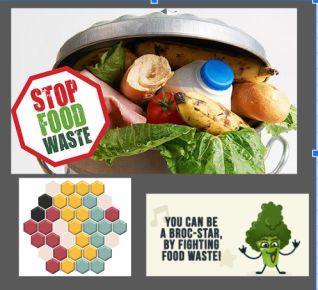One of my favorite “issue” topics to teach about is food waste. Too much of our hard earned dollars are spent on food and feeding our families for it to end up in the garbage! If you teach about food waste and are looking for some new, engaging ways to teach the concept to your students, I encourage you to check out this “New Ways to Teach About Food Waste” post.
garbage! If you teach about food waste and are looking for some new, engaging ways to teach the concept to your students, I encourage you to check out this “New Ways to Teach About Food Waste” post.
Set
- First, be sure you are familiar with the Hexagonal Thinking teaching strategy. Here is a great article from Edutopia explaining it titled, “Using Hexagonal Thinking to Deepen Classroom Conversations“.
- Create enough sets of hexagonal blocks for each group of students to work with ahead of time. Print, cut and place and place blocks in an envelope.
- Place students into small groups. Give them the hex blocks with the following headings: Key Players, Settings, Problems/Effects, Solutions.
- Pass out a set of hex blocks to each group. Instruct groups to begin making connections between the blocks, using the provided headings. Discuss the terms/info on the blocks, show how and why they think the different ideas and options connect. There are no right or wrong answers. In this activity, I want to see what my students know. Just a reminder, hex blocks can connect on one or more sides, up to six.
- As a class, discuss some of the connections made for each category.
Materials
- iPads or Laptops
- Projector & Screen
- Butcher Paper, Glue Sticks & Markers
Activities
- Read the New York Times Upfront article, “Is Your Half-Eaten Lunch Harming the Planet?” aloud, discussing any unknown words.
- Now that students know more about the topic and vocabulary, send them back to their hex blocks to make changes, arranging and rearranging to have the strongest connections. Have them glue the hex blocks in place on the large butcher paper.
- Students must explain their connections with connection arrows, writing directly on the butcher paper why you have created the connections you did between key hexagons. Each person needs to add 3 and initial them. Then have them go back to the article and use the text to give evidence in the form of quotes/page numbers to support why they think their connections are strong ones.
- All groups will orally share their visuals with the class with each student sharing one of their 3 connections/text evidence.
- One way we can reduce food waste is to creatively use up leftovers whether at home or at school. To give students practice creating new meals from leftovers, assign the “Leftover Challenge” project either individually or in their small groups (directions are provided for both). However, before assigning, be sure to go over the guide sheet with students so they understand what you are asking them to do. I’ve also included a SAMPLE for you.
- After the students have completed their challenge, they must answer the follow-up questions.
Attachments
- Food Waste Header Blocks
- Hex Blocks for Food Waste
- Upfront Article
- Leftover Challenge Project & Follow-Up

